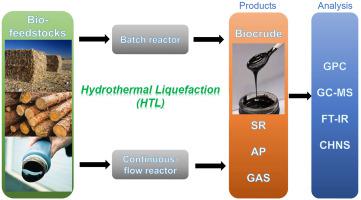Biomass & Bioenergy ( IF 5.8 ) Pub Date : 2023-04-16 , DOI: 10.1016/j.biombioe.2023.106810 Haoyu Wang , Mingyuan Zhang , Xue Han , Yimin Zeng , Chunbao Charles Xu

|
Laboratory- and pilot-scale hydrothermal liquefaction (HTL) of biomass has predominantly been carried out in batch reactor systems. However, the development of continuous-flow reactor systems is critical for industrial deployment of HTL technology in a cost-competitive manner. In this study, a continuous-flow HTL system (with a feed capacity up to 6 kg/h) was developed and employed to convert various types of bio-feedstocks (wood sawdust, cornstalk, and black liquor) into biocrudes in the presence of K2CO3 catalyst at 300 °C for 12 min. The produced biocrude oils were characterized in detail by using GC-MS, FT-IR, GPC, and elemental analysis. This work compared the performance of the continuous-flow HTL process with that of a batch HTL process under the same conditions in terms of the yields and chemistry of the biocrude products as well as the energy recovery potential. The results indicated that HTL of different bio-feedstocks, particularly cornstalk and pinewood, in the continuous-flow reactor led to a higher yield of biocrude (32.4 and 34.5 wt %, respectively) with lower molecular weights and less solid residue (2.9 and 4.6 wt%, respectively) as well as a higher energy recovery rate (53.3 and 52.0%, respectively) compared with those in the batch reactor (Cornstalk: 23.8 wt%, 6.2 wt% and 46.5%; Pinewood: 28.5 wt%, 10.3 wt% and 50.8%, respectively). These promising results shall advance the future development and deployment of the HTL technology in Canadian and global bioenergy sectors.
中文翻译:

通过水热液化从各种生物原料生产生物原油:间歇和连续流操作的比较
生物质的实验室和中试规模的水热液化(HTL) 主要在间歇式反应器系统中进行。然而,连续流动反应器系统的开发对于 HTL技术以具有成本竞争力的方式进行工业部署至关重要。在这项研究中,开发了一种连续流动的 HTL 系统(进料能力高达 6 kg/h)并用于将各种类型的生物原料(木屑、玉米杆和黑液)转化为生物原油K 2 CO 3催化剂在 300 °C 下处理 12 分钟。使用 GC-MS、FT-IR、GPC 对生产的生物原油进行了详细表征和元素分析。这项工作在生物原油产品的产量和化学性质以及能量回收潜力方面,比较了相同条件下连续流 HTL 工艺与间歇式 HTL 工艺的性能。结果表明,连续流动反应器中不同生物原料(尤其是玉米杆和松木)的 HTL 导致更高的生物原油产量(分别为 32.4 和 34.5 wt%)和较低的分子量与间歇式反应器(玉米杆:23.8 wt%、6.2 wt% 和 46.5%;松木:分别为 28.5 wt%、10.3 wt% 和 50.8%)。这些有希望的结果将推动 HTL 技术在加拿大和全球生物能源领域的未来发展和部署。











































 京公网安备 11010802027423号
京公网安备 11010802027423号